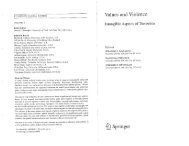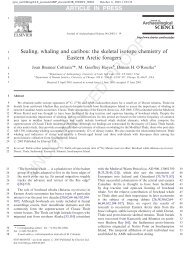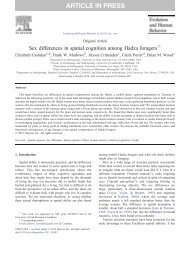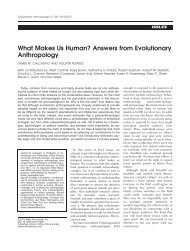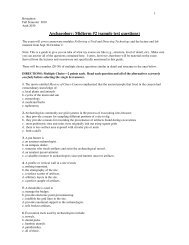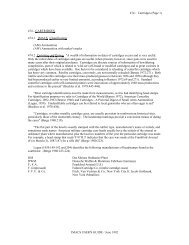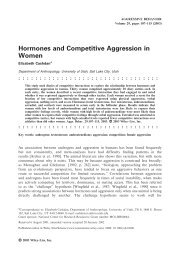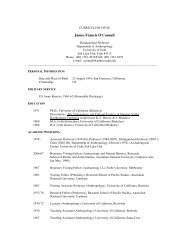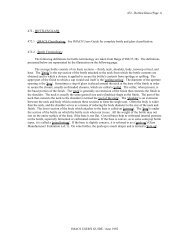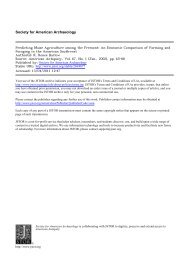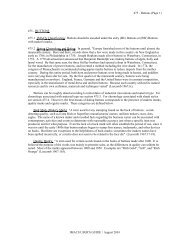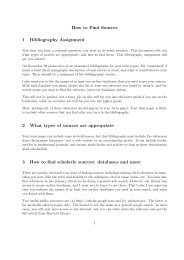476 - Shoes (Page 1) IMACS USER'S GUIDE / August 2001 476 ...
476 - Shoes (Page 1) IMACS USER'S GUIDE / August 2001 476 ...
476 - Shoes (Page 1) IMACS USER'S GUIDE / August 2001 476 ...
You also want an ePaper? Increase the reach of your titles
YUMPU automatically turns print PDFs into web optimized ePapers that Google loves.
<strong>476</strong> - <strong>Shoes</strong><br />
<strong>476</strong>.1 <strong>IMACS</strong> Classification :<br />
(AS) Animal shoes<br />
(SO) <strong>Shoes</strong><br />
<strong>IMACS</strong> <strong>USER'S</strong> <strong>GUIDE</strong> / <strong>August</strong> <strong>2001</strong><br />
<strong>476</strong> - <strong>Shoes</strong> (<strong>Page</strong> 1)<br />
<strong>476</strong>.2 Shoe History and Dating : "The old way of doing things in the shoe making business meant using<br />
wooden pegs, hand driven, to join soles and uppers. <strong>Shoes</strong> in the western world were universally made this<br />
way until the early 1800s. About 1810, and after Brunel's work with clamping presses, an American<br />
developed a similar invention as did two Frenchmen, Gengembre and Joliciere, working in Paris. Their<br />
efforts were followed in 1822 by a German shoemaker from Stuttgart, a man named Brecht, who conceived<br />
the use of screws for joining soles and uppers. Brecht's idea culminated before 1880 in a process in which a<br />
thread was cut upon a brass 'cable screw' wire. The screw thus made was then forced through sole and upper<br />
placed on an arm beneath, riveted, and then cut off. This was repeated as the shoe was advanced by the<br />
workman until the operation was finished, the whole being effected automatically by a single machine. The<br />
ends of the wires were then cut off and filed down, and the heels were nailed to the shoes by machinery<br />
(Knight 1882:III: 2158, 2162; Turner 1948:138)" (Fontana et al. 1962:105-106).<br />
"As a rule of thumb, one can safely say that it was about 1812 before shoe nails replaced wooden pegs.<br />
Shoe-nailing machines, such as that finally perfected by Nathaniel Leonard of Merrimac, Massachusetts in<br />
1829, did not drive finished nails into shoes. Rather they drove wire which the machines then cut and<br />
subsequently, in some instances, headed. In other words, the presence of actual square cut iron nails or<br />
square cut brass nails in a shoe dates it post-1812. Metal fasteners of any kind, especially wire, in a shoe<br />
date it certainly post-1800 and most likely post-1829" (Fontana et al. 1962:105-106).<br />
"Sometime between the 1800s and the present day brass shoe pegs and nails ceased to be made. We<br />
have not been able to establish any dates. Modern shoe nails, both wire and square cut, are iron, coated or<br />
otherwise treated to make them resistant to corrosion. There are many kinds, but among the more common<br />
varieties are the square cut clinch and soling nails; the wire top-lift and hold-fast nails; and the twisted wire<br />
fed into a machine from a spool to be cut at any desired length after it has been driven into the shoe. This<br />
machine is a descendant of that invented by Brunel at the onset of the 19th century and perfected by Leonard<br />
in 1829" (Fontana et al. 1962:105-106).<br />
The following summary is from Anderson (1968:62-64).<br />
During the industrialization of the nineteenth century a number of important technological innovations<br />
took place within the shoe industry. Each development was marked by some distinctive feature which<br />
provides the archaeologist with valuable technological data. The twentieth century has been a period of<br />
stylistic experimentation and innovation, but today's shoes are manufactured by the same methods used in<br />
1912 and are processed by the same types of machines.
<strong>IMACS</strong> <strong>USER'S</strong> <strong>GUIDE</strong> / <strong>August</strong> <strong>2001</strong><br />
<strong>476</strong> - <strong>Shoes</strong> (<strong>Page</strong> 2)<br />
There are two basic types of shoes: turned shoes and shoes whose upper is attached to the insole and<br />
reinforced by the outsole and heel. The upper of a turned shoe is sewn inside out to a single, thin sole.<br />
Then it is turned right side out. Today turned shoe manufacture has generally been replaced by the<br />
cementing process, but archaeologically this form abounds and can be easily recognized. The single sole<br />
has a thin, feathered strip of leather on the inside of the sole. The upper is stitched to this strip when inside<br />
out.<br />
Any mass-produced shoe can be further placed into one of three groups based on the method of<br />
attaching the outsole to the upper. A shoe is nailed (or pegged or screwed), sewn, or cemented. Even<br />
fragmentary pieces of sole leather generally betray the method of manufacture. Nails may still be intact, or<br />
their corroded remains visible in a nailed shoe. If the nails are gone, the round hole remains. There are no<br />
channels, feathered ridges or ribs. Thread from a stitched shoe will probably be gone, but small needle<br />
holes will remain. These are generally much smaller than those left in nailed shoes and are slightly oval.<br />
There may be indentations in the leather between the holes, indicating tightly pulled thread. Sewn shoes<br />
will have an outsole channel where the stitching occurs to keep the thread from being worn. They may also<br />
have a feathered edge on the bottom of the outsole with the stitching underneath. Feathering was a method<br />
used around the turn of the century for protecting stitches from wear. Often this feathering is worn off at<br />
the ball of the outsole, but will still be present on the shank. A McKay shoe will have stitching on the<br />
inside of the insole. If the stitching does not include the toe and heel, it may be dated before McKay's 1862<br />
patent. Goodyear Welt shoes are recognized by the unique rib on the underside of the insole. Cemented<br />
shoes occur late and are distinguished by the fact that the part of the upper cemented to the insole will be<br />
intact. This glued piece may be the only remaining fragment of a cement shoe's upper.<br />
A study of fashions and stylistic changes provides another source of chronological information.<br />
However, consideration of styles is outside the scope of this paper. Reports on shoes should utilize the<br />
terminology for shoe parts and manufacturing processes that are standard within the shoe industry. Primary<br />
sources, including shoe manufacturers' guides, trade catalogues, and patent records should always be<br />
consulted. Archaeological and other reports have relied on secondary sources containing factual errors which<br />
are perpetuated in the literature.<br />
Footwear can be dated by technology alone. Archaeologists working in post-1850 sites need to be<br />
aware of the information that can be derived from old shoes.<br />
"Innovations in the shoe making industry have been cited by Anderson (1968) and include some easily<br />
identifiable and datable changes. Foremost in importances, we have discovered, were the developments of<br />
the 'Goodyear Welt' technique of shoe manufacture in 1875 and the all rubber heel, an innovation of 1895"<br />
(Buckles et al. 1978a:445, 448).
<strong>476</strong>.3<br />
Shoe Chronologies :<br />
1. Chronological summary from Fontana et al . (1962) and Buckles et al . (1978):<br />
Circa Pre-1812 - Wooden pegs, hand driven, to join sole and uppers.<br />
Circa Post-1812 - Wood pegs replaced by square cut iron or brass nails.<br />
Circa Post-1829 - Metal fasteners of any kind, especially wire.<br />
Post-1875 - Goodyear Welt construction.<br />
Post-1895 - All rubber heel.<br />
2. Shoe Chronology taken from Berge (1980:275-278):<br />
<strong>IMACS</strong> <strong>USER'S</strong> <strong>GUIDE</strong> / <strong>August</strong> <strong>2001</strong><br />
<strong>476</strong> - <strong>Shoes</strong> (<strong>Page</strong> 3)<br />
The styles of shoes have changed through time as clothes fashions have changed, but not as drastically<br />
as in our own time (Wilson 1969:1).<br />
Anderson (1968) presents an outline of shoe improvements during the nineteenth century. It is further<br />
listed with some additions (Wohl Shoe Company) as follows:<br />
until 1750 Shoemakers worked in their own homes, hand crafting footwear.<br />
1800 <strong>Shoes</strong> were made ready-to-wear.<br />
Patent leather was introduced.<br />
1812 Shoe nails were manufactured in New England to replace the wooden peg; also<br />
the lathe was developed.<br />
1844 Charles Goodyear discovered and patented the process of vulcanization, which<br />
included the manufacture of rubber shoes, soles and fishing boots.<br />
1846 Elias Howe, Jr., patented a sewing machine, making it possible to stitch shoe<br />
uppers rapidly.<br />
1850s The first sport shoes were manufactured with a laced fabric top and a rubber sole,<br />
later to be called the 'sneaker'.<br />
1860 Lyman R. Blake, Abington, Massachusetts, patented a sewing machine that sewed<br />
the sole to the upper shoe. It "left a loop stitch and ridge of thread on the foot<br />
side of the insole, and did not stitch the heel or the toe".<br />
-------- Lasts were developed to distinguish between right and left shoes.
<strong>IMACS</strong> <strong>USER'S</strong> <strong>GUIDE</strong> / <strong>August</strong> <strong>2001</strong><br />
<strong>476</strong> - <strong>Shoes</strong> (<strong>Page</strong> 4)<br />
1862 Colonel Gordon McKay patented improvements on Blake's sewing machine, which<br />
enabled the seams to be made completely around the shoe. This invention<br />
lightened shoe construction, eliminating pegs or nails. This machine left stitching<br />
on the foot side of the insole.<br />
-------- Eugene Lemercier formed a screw from a continuous brass wire, forced it into the<br />
leather, and cut it off automatically.<br />
1874 The eyelet-setting machine was developed.<br />
1875 Charles Goodyear, Jr., perfected the Goodyear Welt Stitcher, which used a curved<br />
needle to stitch the welt to the upper shoe and to the sole at the same time.<br />
1888 Standard shoe sizes were developed.<br />
ca. 1912 Manufacturing techniques were standardized: Goodyear Welt, McKay, turned,<br />
standard screw, and nailed.<br />
1915 Saddle shoes were first worn.<br />
1926 Cement shoe production by gluing of the sole to the upper shoe.<br />
1937 Wedged soles were introduced.
<strong>476</strong>.4<br />
Shoe Illustrations (from Anderson 1968)<br />
See ILLUSTRATIONS section.<br />
<strong>IMACS</strong> <strong>USER'S</strong> <strong>GUIDE</strong> / <strong>August</strong> <strong>2001</strong><br />
<strong>476</strong> - <strong>Shoes</strong> (<strong>Page</strong> 5)
<strong>476</strong>.5<br />
Animal <strong>Shoes</strong> : The following information is adapted from Berge (1980).<br />
<strong>IMACS</strong> <strong>USER'S</strong> <strong>GUIDE</strong> / <strong>August</strong> <strong>2001</strong><br />
<strong>476</strong> - <strong>Shoes</strong> (<strong>Page</strong> 6)<br />
Horseshoes<br />
"The normal horseshoe has the form of a constricted arc with the same three general sections as the<br />
foot, ie., toe, quarter, and the heel. The area from the toe to the heel on each side of the shoe is termed the<br />
branch or wing (Great Britain 1908:227). These branches can be either inner or outer, depending on the<br />
position of the shoe in relation to the body median. The area of the shoe which comes in contact with the<br />
ground is the ground surface, and the opposite side is the hoof-surface. That portion of the shoe which<br />
comes into direct contact with the hoof is the bearing-surface. The fuller is a groove which usually<br />
extends the length of the quarter but may include the entire arc of the shoe, from heel to heel. Nail holes<br />
are punched into the fuller, and this groove prevents the wearing away of the nail head, thereby preventing<br />
the untimely loss of the shoe. The fuller also prevents slipping and aids the farrier in punching the nail<br />
holes more easily and accurately (Fitzwygram 1903:479). Seating is used to take the pressure off the sole<br />
in order for the wall to take the entire pressure of the horse's weight. The "web" of the shoe (width of the<br />
branch) is "the whole of the substance of the shoe ... and the width of the web, cover, e.g., a wide-webbed<br />
shoe, is frequently spoken of as having 'plenty of cover' (Great Britain 1908:227).<br />
Normal front shoes are easily distinguishable from normal hind shoes. The front shoes are more nearly<br />
circular at the toe and quarter, and are usually wider at the heels. The hind shoes are more pointed at the toe<br />
and quarters, and usually narrower at the heels (Hayes 1960:448).<br />
Mule <strong>Shoes</strong><br />
"The structure and characteristics of the hooves of these animals are quite similar to those of the horse,<br />
differing chiefly in the narrow and the round at the toe, the sole is well-arched, and the side walls are rather<br />
steep. In the ass the narrowness of the hoof is still more pronounced, the wall is relatively wide in the<br />
region of the quarters. The horn of both the mule and the ass is tough.<br />
The shoes differ from those of the horse in no other respect than that they should be lighter and<br />
narrower. Four nail-holes are sufficient for an ass's shoe, and five to six for a mule."<br />
Oxen <strong>Shoes</strong><br />
"The shoeing of oxen is essentially different from that of horses, because the foot of the ox is cloven<br />
(split), the long pastern, short pastern, and hoof bone are double so that instead of one hoof or claw, there<br />
are two upon each foot, distinguished as outer and inner. Each claw consists of wall, sole, and bulbs; the<br />
frog is absent. The wall is considerably thinner than that of the horse's hoof, the sole is thin, and the bulbs<br />
are low. For these reasons the shoe designed for a claw must be thin, but wide."<br />
Nails<br />
There are hand-made and machine-made horseshoe nails, both of which have their specific advantages<br />
and disadvantages (Lungwitz 1908:109). There are two primary types of nails: (1) rose-headed
<strong>476</strong>.5 -<br />
ANIMAL SHOES<br />
See ILLUSTRATIONS section.<br />
<strong>IMACS</strong> <strong>USER'S</strong> <strong>GUIDE</strong> / <strong>August</strong> <strong>2001</strong><br />
<strong>476</strong> - <strong>Shoes</strong> (<strong>Page</strong> 7)
<strong>IMACS</strong> <strong>USER'S</strong> <strong>GUIDE</strong> / <strong>August</strong> <strong>2001</strong><br />
<strong>476</strong> - <strong>Shoes</strong> (<strong>Page</strong> 8)<br />
nail and (2) countersunk nails. Rose-headed nails are employed with shoes that have not been fullered; the<br />
head does not enter the nail hole. Countersunk nails are embedded into the web, having either a half or full<br />
counter (Great Britain 1908:233). There are also frost-nails (edged like a screwdriver) used in the winter to<br />
perform the same task as a calk (Lungwitz 1908:119).



